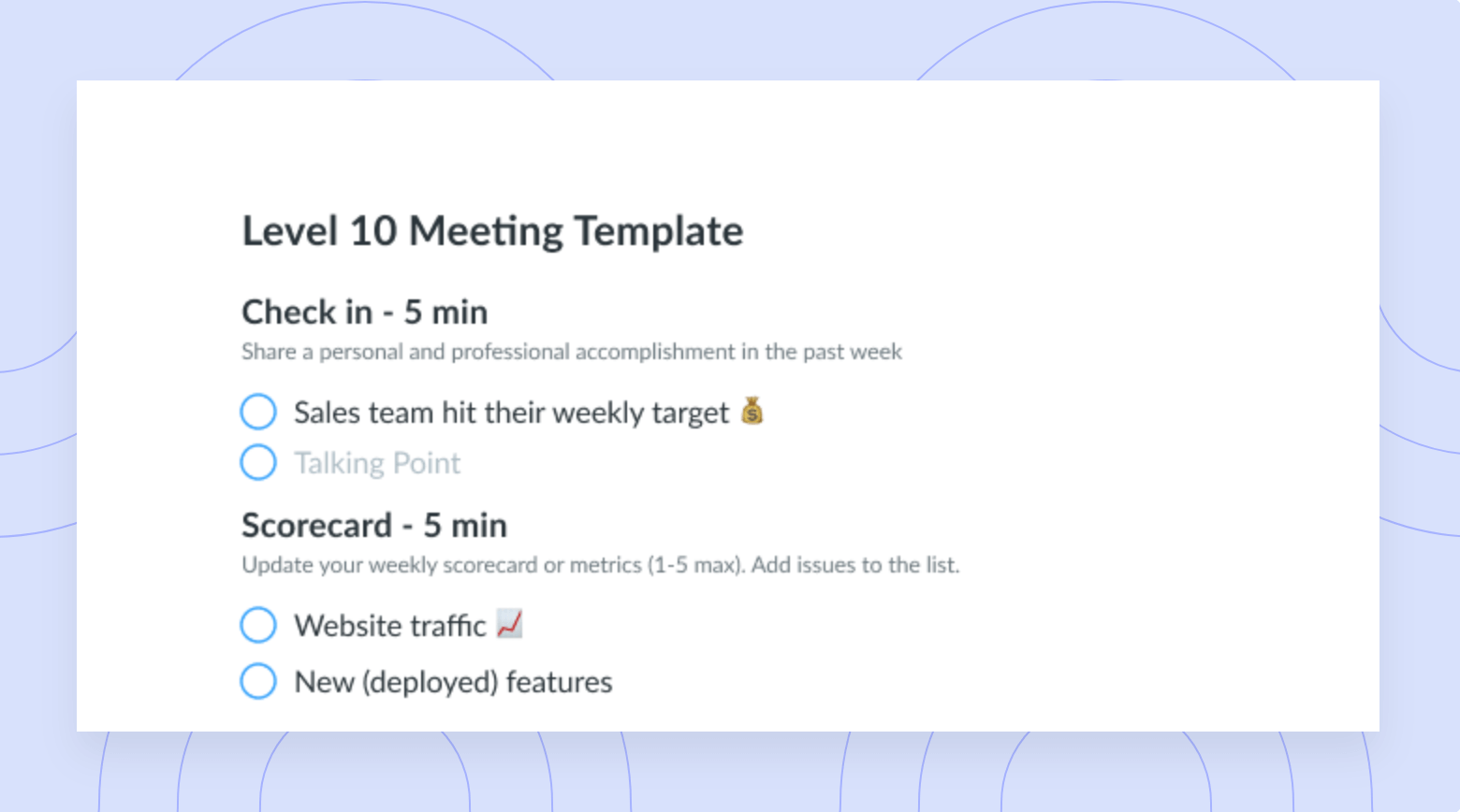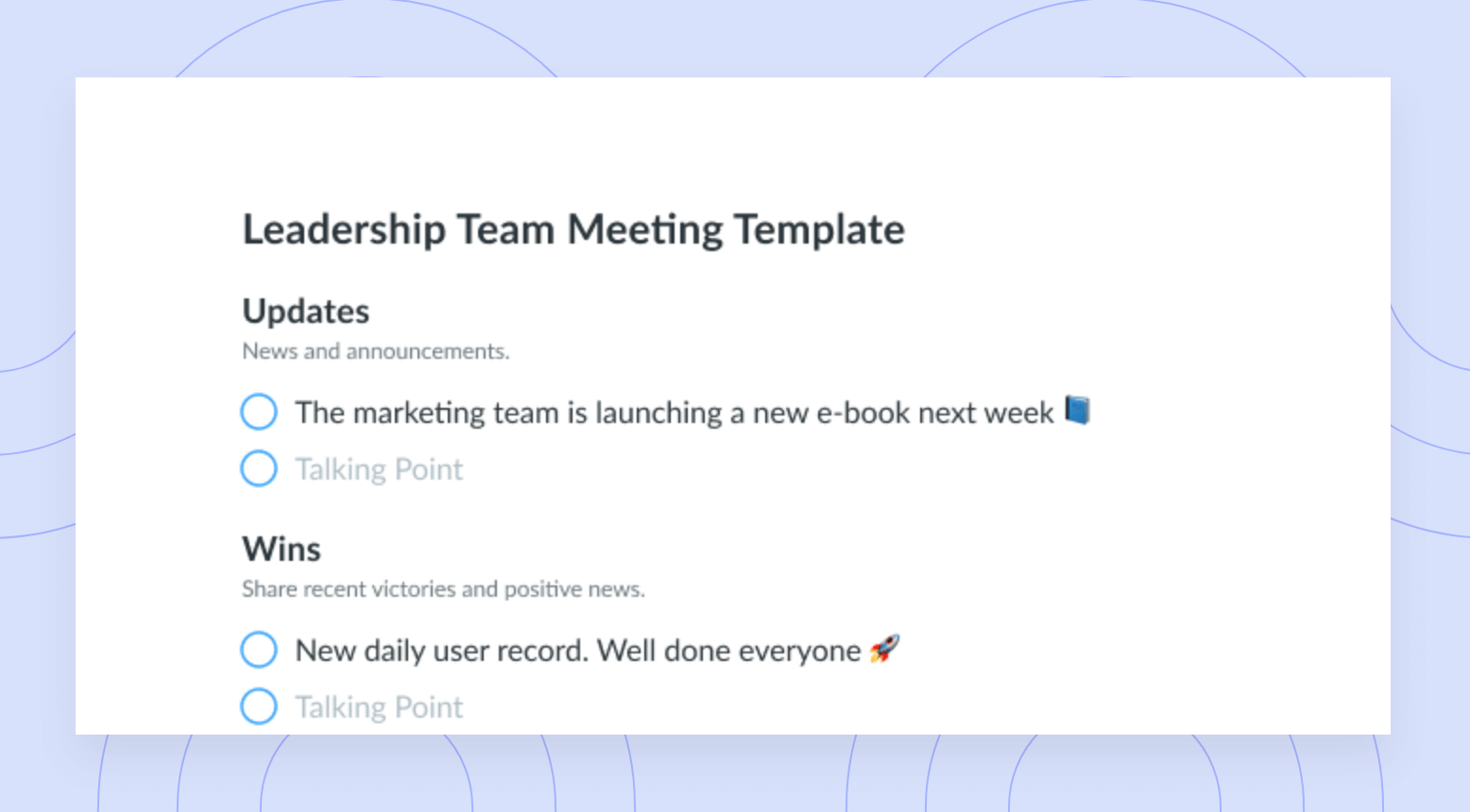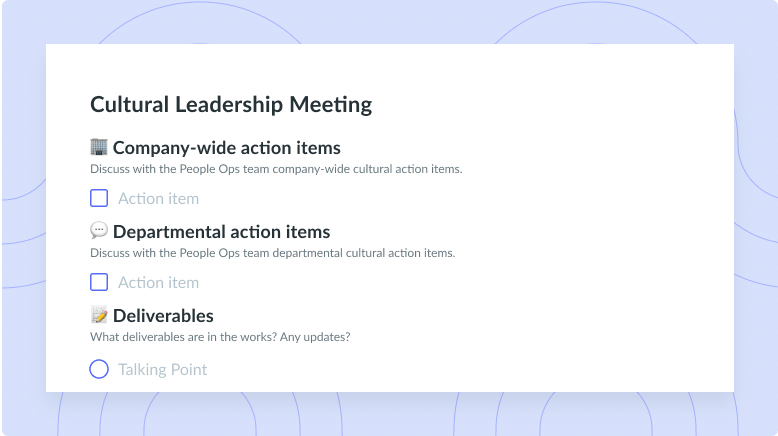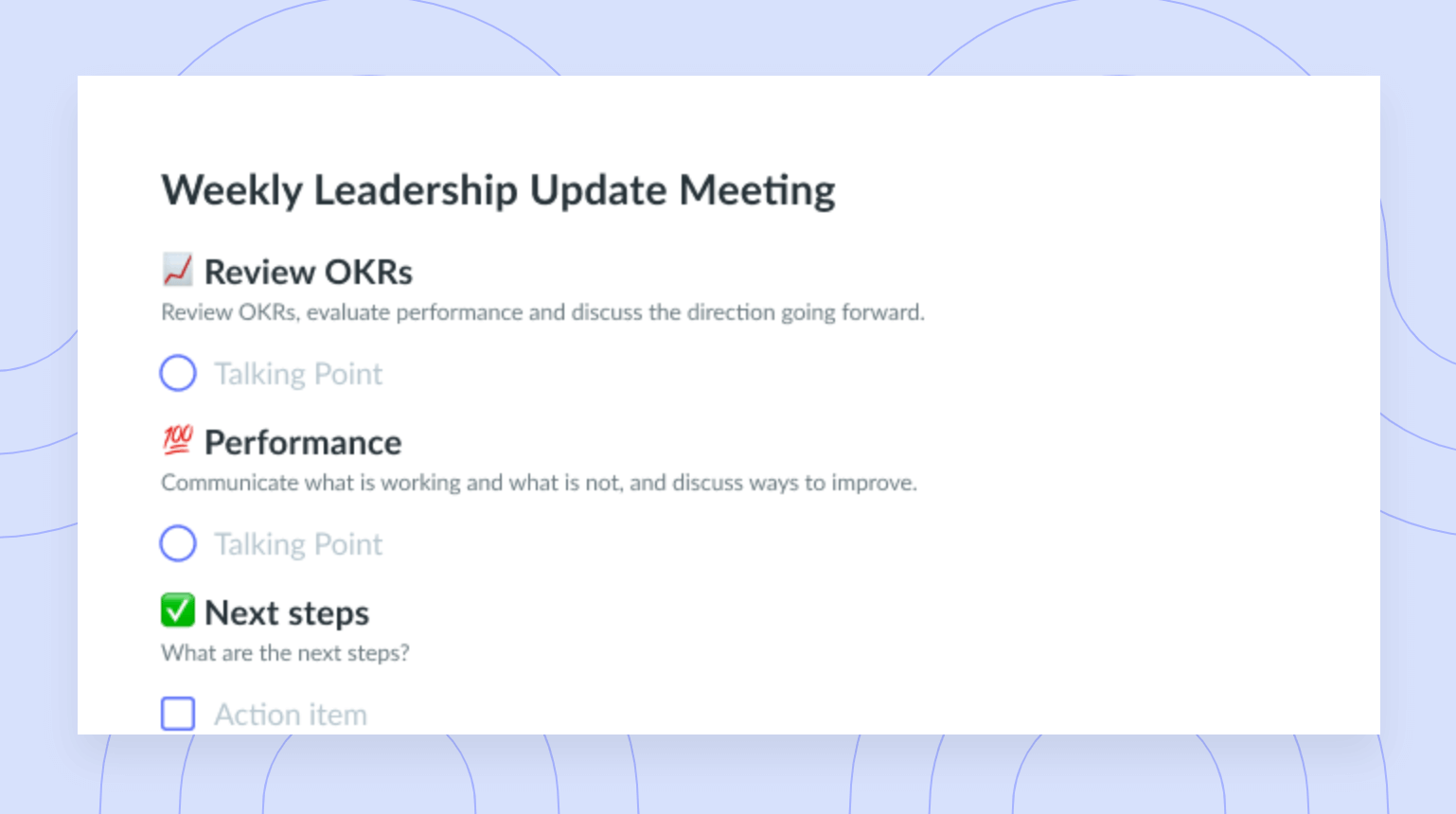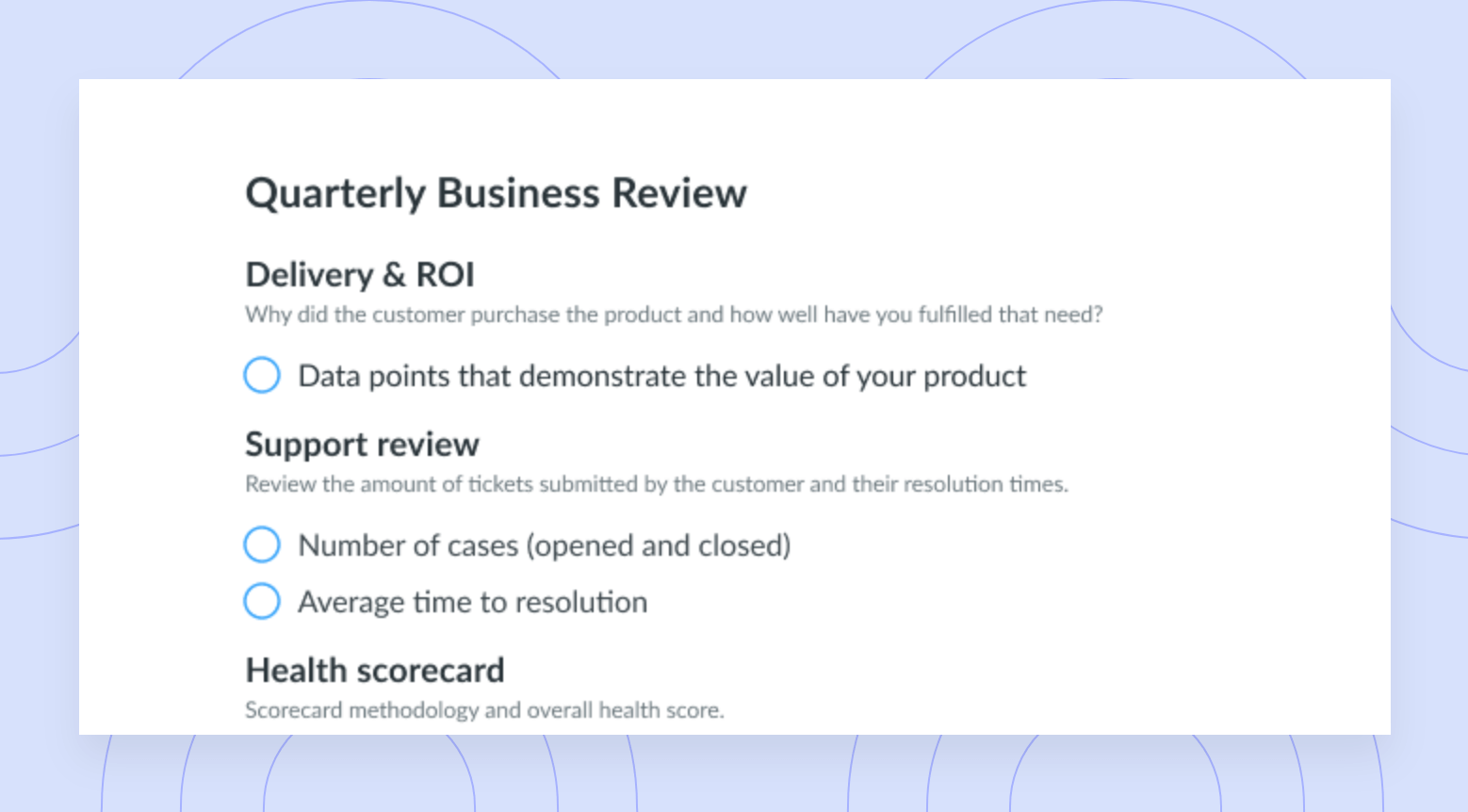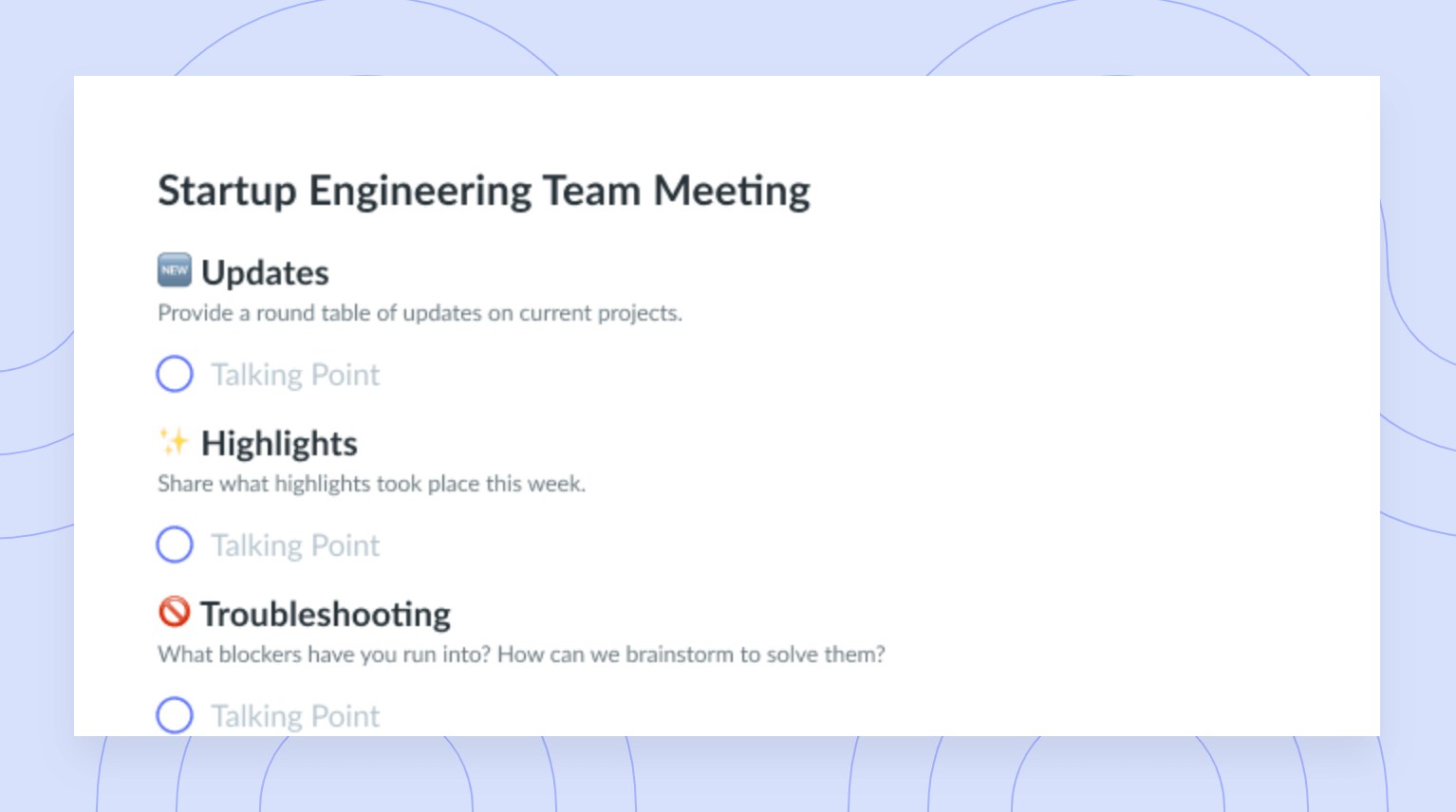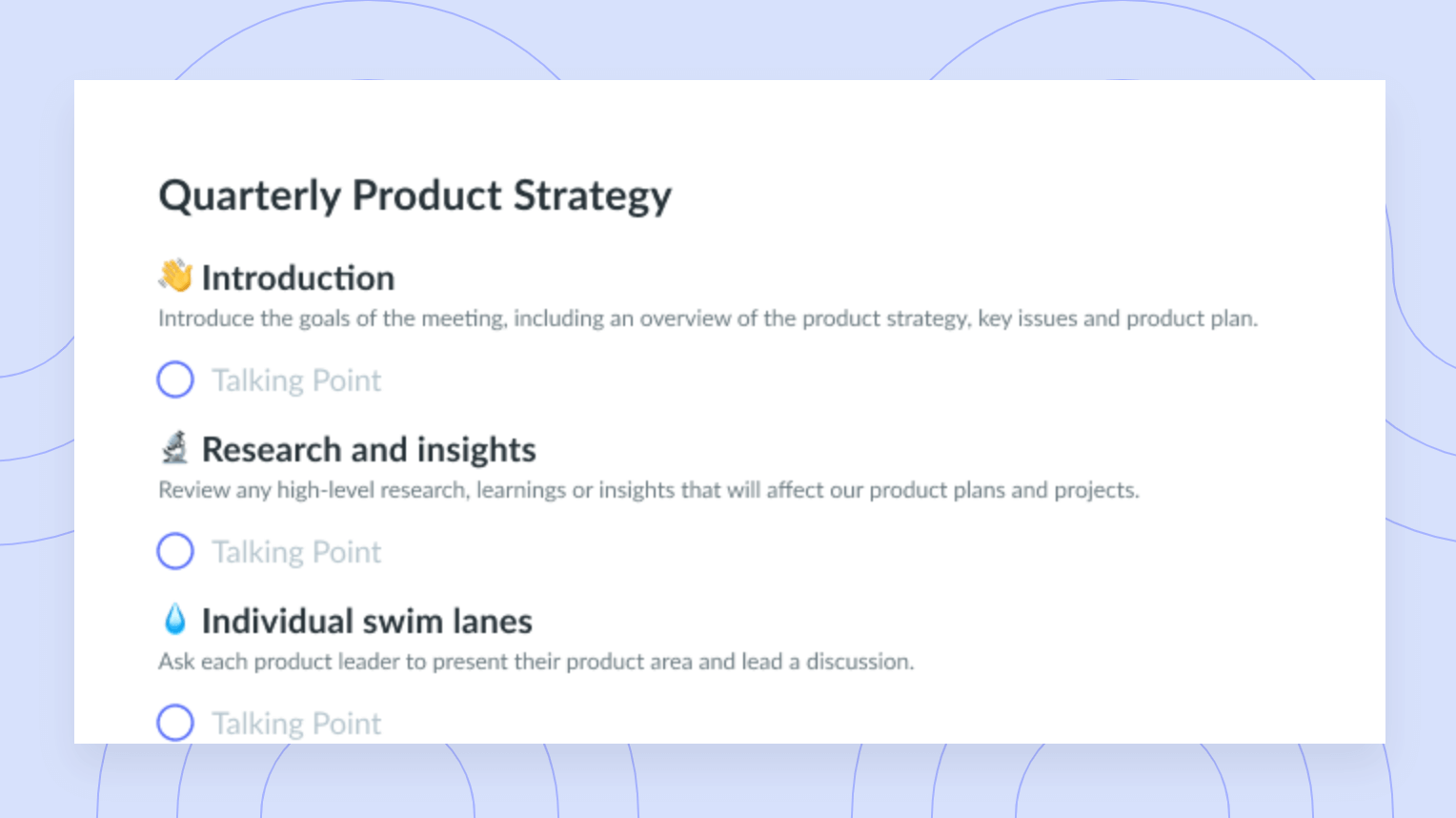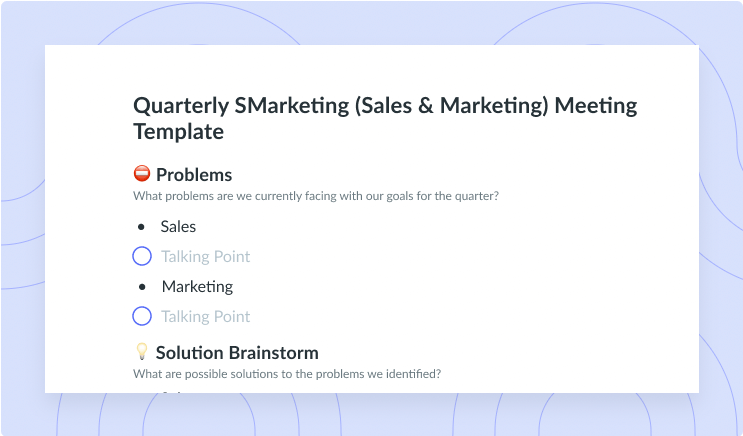How to run a Leadership Team Meeting [Compatible with EOS®]
Learn why thousands of leadership teams are using this leadership team meeting template to identify and solve issues collaboratively.
The Entrepreneurial Operating System (EOS®) was created by author and businessman, Gino Wickman, who describes the system as:
“A set of timeless business principles and real-world tools that help entrepreneurs get what they want from their businesses.”
Under this operating system, the solution to having too many meetings is to actually have another meeting. Sound terrible? Don’t be so quick to judge. Thousands of companies are using this leadership team meeting template (Compatible with EOS®) to identify, discuss and solve issues, and it’s actually very effective.
In this article, the Fellow team is going to highlight what a leadership team meeting (compatible with EOS®) is, go through a meeting agenda, and talk about the pros and cons of this type of meeting. Keep scrolling to learn more!
- Why leadership team meetings are important
- Leadership team meeting agenda
- Pros of leadership team meetings
Why leadership team meetings are important
A leadership team meeting is a weekly check-in meeting with your leadership team, where attendees develop a strategy that they can hold themselves and their team accountable to. These team meetings are principally dedicated to solve issues and create an issues list of items that require attention.
A recent article by Grow Exceptional provides a great explanation of what these meetings really are:
“It’s a 90-minute weekly meeting, held amongst the company leadership team. While 25 minutes are reporting, a full 60 minutes of every meeting is spent on truly solving the top 1-3 issues: issues that probably have crept up time and again, month over month, for years! Imagine if you put your heads around even one root issue – and solved it – every week. If I’m doing the math right, you’d be solving over 50+ real company issues a year.”
Now that you have an understanding of what these meetings are, let’s go through a leadership team meeting agenda so that you can see the topics that are discussed and the amount of time that needs to be allocated to each meeting agenda item.
Leadership team meeting agenda (compatible with EOS®)
This meeting agenda remains consistent and identical for every business that uses it. Scroll down to read our explanation and recommended duration for each section!
- Check-in
- Scorecard
- Rock review
- Customer/employee headlines
- To-do list
- Issues
- Recap

1 Check in – 5 minutes
Ask each participant to briefly share a personal and professional accomplishment in the past week. Starting the meeting with a win is going to set a positive tone for the rest of the conversation.
2 Scorecard – 5 minutes
Use these 5 mins to update your weekly scorecard or metrics for each attendee. Only address 1-5 of the most important metrics. This section is not to engage in discussion, but to add issues to the issues list.
In an article by GrowBeyond, they communicate more specifically what your scorecard section should look like:
“Each measurable will have a goal next to it and an owner, who is accountable for hitting this goal, will be in your leadership team. For example, you may track the number of sales calls made each week and have a goal of 100 calls per week. The owner of this number would be your sales and marketing director. During the scorecard review, you review each measurable with the owner of each one saying what the actual number was for the last week.”
3 Rock review – 5 minutes
Each participant simply states if they’re on track or off track for each assigned major (90-day) goal, which is referred to in leadership team meetings as a “rock”. Here, also add issues to the issues list.
4 Customer/employee headlines – 5 minutes
Share your client and employee feedback with the rest of the team, with one sentence, indicating good or bad. Still, no discussion but continue to add issues to the issues list.
5 To-do list – 5 minutes
Each team member either says that they’re done, not done, or if an item is in progress for each of their responsibilities from last week’s to-do list. Hold off on the discussion here and keep adding issues to your issues list.
6 Issues – 60 minutes
Finally, this is where the discussion begins. IDS stands for: Identity, Discuss and Solve. This is the 3-step problem resolution method you’re going to use to understand the root of problems, discuss the problems and then identify specific action items that individual team members can take to resolve the problems.
Taking the time to constructively solve problems is going to be a lot more effective than jumping to quick solutions. It’s all about the journey, not the destination, right? Start by prioritizing all of the issues and then use IDS to work through them, by order of priority.
7 Recap – 5 minutes
Take this final section of the leadership team meeting agenda to recap your to-do list and identify the next steps from the meeting. The author of the book “The Surprising Science of Meetings”, Steven Rogelberg discussed the importance of meeting feedback on episode 72 of the Supermanagers podcast.
“If your team is having frequent meetings, you do this very basic assessment, and then you try some new things, and see how they work. And then you reassess down the road. But what I like to remind managers is, think about the cultural message that sent, if your people think that you care about their time and that you’re collecting information, and then you’re willing to try something new. These are like the cultural values that you want every manager to have: reasonable experimentation, not get stuck in the status quo, challenge the status quo, a thirst for constant improvement. So bring it to the meeting space.”
Pros of leadership team meetings
1 Keep your team aligned on goals
By focusing on your business goals and the most important challenges that your organization is facing once a week, you and your team members are going to stay focused and productive.
It’s hard to forget what the business objectives are and which goals you’re working towards crushing when there’s a meeting to follow-up every week. The leadership team meeting serves as a constant reminder of what you need to resolve so that you can move on to the next obstacle, and your business can thrive.
2 Focus on your team’s issues
The real purpose of the leadership team meeting is to discuss your team’s issues. It’s not often that you’d dedicate a whole hour to issue resolution, so make sure to take advantage. You can really dive deep into the issues that the team is facing so that you can collaborate and strategize a means to mitigate problems and alleviate complications on the way to achieving your goals.
3 Save time
This one’s sort of obvious but still totally note-worthy. Having a strictly time-capped meeting like this is going to keep you and your team members focused on resolving issues. Because there’s a time limit, each person is pushed to be concise and to-the-point, with only enough time to communicate pressing and important information.

Conclusion
It’s never a bad idea to try something new, and we actually think that leadership team meetings are worth a go for a lot of leadership teams. Business Coach, Toby Cryns brings up a point that you might have been thinking of the whole time you were reading this article:
“There are lots of business frameworks out there, and, frankly, some resemble pyramid schemes. You’ll have to sift through the cruft to find your best fit system (I use a highly modified version).”
It’s true: A lot of business frameworks make us want to turn away because we simply can’t take on the risk. That being said, EOS® and leadership team meetings have been tested and tried by thousands of companies over the last fifteen years. It comes down to recognizing if this kind of approach to a weekly leadership meeting is right for you and your organization. If what you’re doing right now isn’t working, why not give it a go?
Thanks for taking the time to give this a read and don’t forget to share with a friend or a colleague who could benefit!

Productive meetings start with an agenda
Meetings being booked without a purpose or going completely off-topic? Fellow’s collaborative approach transforms meetings into productive work sessions you’ll want to attend.

![How to Successfully Run a Team Update Meeting [+ Examples]](https://fellow.app/wp-content/uploads/2022/06/How-to-Run-a-Team-Updates.jpg)








